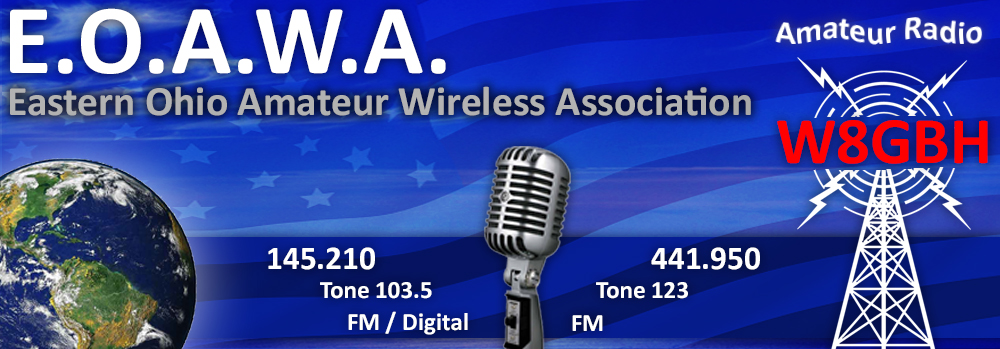Welcome to the Eastern Ohio Amateur Wireless Association: Station W8GBH
Location: Belmont County EMA
68329 Bannock Uniontown Road St. Clairsville, OH 43950
Phone: (M-F) 740-695-5984 Follow us on Facebook!
The EOAWA Club meets on the 2nd Thursday of the month at 6:30PM. Club meeting are open to the public, however participation is restricted to club members only. All persons licensed in amateur radio communications are eligible for membership.
The Yaesu Digital / FM 145.210 PL 103.5 repeater and the FM 441.950 PL 123 repeater are both located in St. Clairsville Ohio along Interstate 70 near milepost 215. These are open repeaters for club members and those with club permission for use.
About Amateur Radio
Amateur Radio, or as it is often called Ham Radio, is a fantastic hobby that anybody can enjoy. It is a hobby that an individual or whole family can be a part of, regardless of age, sex, religion, race, or nationality it doesn’t matter. You can talk to your neighbor down the street or talk to someone on the other side of the world. Getting a ham radio license has never been easier. All you have to do is pass a fairly simple FCC test and you can have a ticket.
A little Ham Radio History…
Years ago you actually had to go to an FCC regional office to take a test (this has changed see below). There used to be five classes of amateur radio licenses; Novice, Technician, General, Advanced and Amateur Extra. All the tests had to be taken in order. Plus you had to learn Morse Code to get a license.
To get a Novice license you had to take a test plus be able to copy Morse code at 5 words per minute. The Technician license only required another test. The General license required another test plus be able to copy Morse code at 13 words per minute. The Advanced license only required another test. The Extra class license required another test plus be able to copy Morse code at 20 words per minute. The only short cut allowed was on the Morse code tests. If you could pass the 13 WPM test you didn’t have to take the 5 WPM test. Or if you could pass the 20 WPM test then you didn’t have to take the 5 WPM or 13 WPM tests.
I really admire and personally have a deep respect for the ones who got their license back then for they are the True Amateur Radio Operators.
You no longer have to go to an FCC regional office to take an amateur radio test. We now use the Volunteer Examiner (VE) system. A minimum of three certified volunteer examiners can give you any of the tests you want to take. Test sessions are given all the time just about everywhere in the country. You can check the American Radio Relay League (ARRL) website for some testing sessions. You can check with local Amateur Radio clubs to see when they are having test sessions. Most Hamfests (amateur radio flea markets) have test sessions. Search the web, a lot of ham radio sites list when they are having test sessions. Just ask around it should not be difficult to all to find a place to take the tests.
Back in the early 1990’s some changes began…
The FCC started the “No Code Technician” license. Beginning on February 14, 1991, If you passed the Novice written exam and the Technician written exam, the FCC would grant you a “No Code Technician” license. With the No Code Technician license you were allowed full privileges above 50 MHz. You were not permitted any privileges below 30MHz. This actually created a second entry level class. If you passed any of the Morse code tests, you gained access to the so-called Novice HF privileges, essentially “upgrading” to what a Tech had before the new rules went into effect. In 1994 the FCC started calling this class “Technician Plus.”
On April 15, 2000 the FCC moved to simplify the Amateur Radio Service operator license structure this restructuring as it was called streamlined the number of examination elements, and reduced the emphasis on Morse code.
Then the major changes began…
A reduction of the number of operator license classes from six to three. The Advanced Class, Technician Plus Class, and Novice Class licenses would no longer be issued; however, existing licensees would retain their operating privileges and be allowed to renew their licenses. The Technician Class, General Class and Extra Class are the only classes available now. A reduction of the number of Morse code examination elements from three to one. Both the 20 words-per-minute (WPM) and 13 WPM Morse code tests were removed, the only requirement was a 5 WPM Morse code test for both the General and Extra Class licenses.
The end of the Morse Code requirement:
On February 23, 2007 the FCC adopted rule changes which would eliminate the Morse code requirement for all amateur operator licenses. No Morse Code is required for any license. It has NEVER been easier to get a Ham Ticket than it is right now. Take and pass the Technician test and you can have your ticket. Want to upgrade your license just take and pass the General test. If you want to have the top Amateur Radio License after you pass the General test just take and pass the Extra test. That’s all there is to it!
